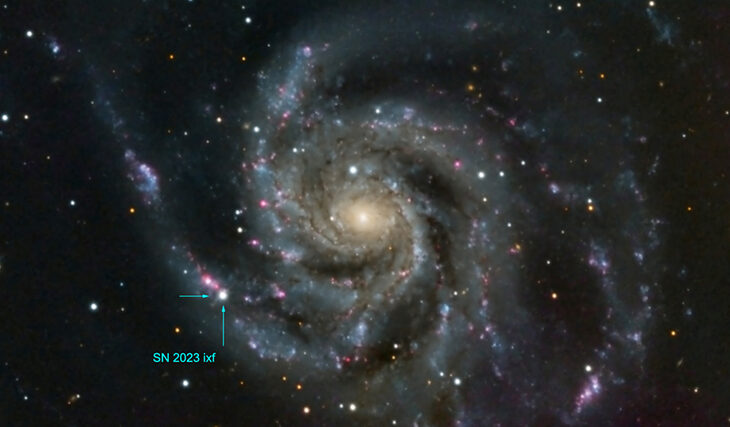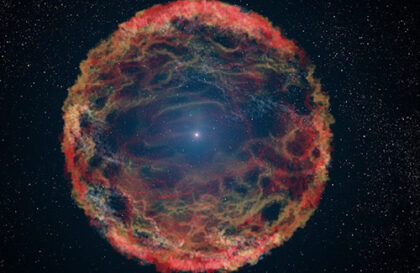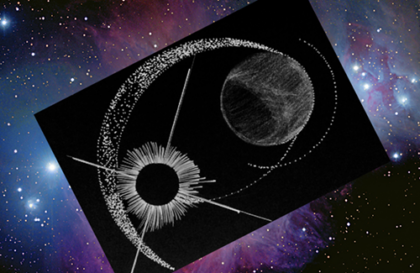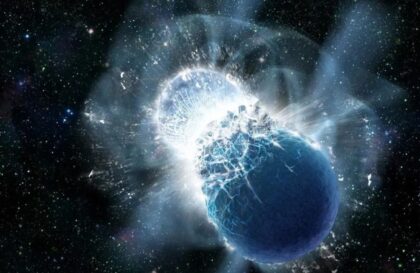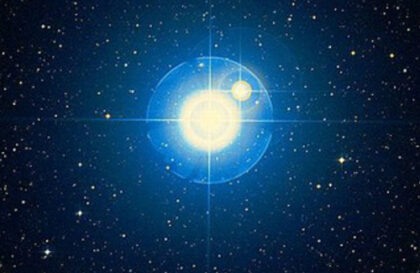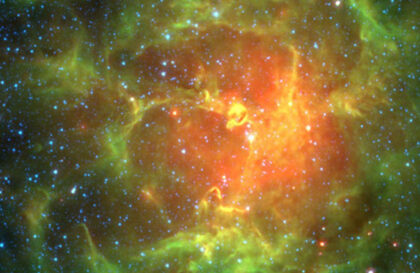A discovered supernova in the Pinwheel Galaxy lost mass equal to the Sun before exploding and has provided new details about the death of massive stars.
Amateur astronomer Itagaki has discovered more than 170 supernovae, slightly surpassing Briton Tom Bowles’ 150+ discoveries. He used telescopes in the cities of Yamagata, Okayama, and the island of Shikoku.
His latest discovery, supernova SN 2023ixf, is unique in its location in the nearby Pinwheel galaxy (Messier 101), 20 million light-years from Earth. The discovery has attracted the attention of amateur astronomers worldwide, as Pinwheel is a popular spot for observation. The detection speed of supernovae is vital for studying their early stages, which is often missed due to late detection. Too often, a supernova is noticed several days after the explosion, so its earliest stages are not seen.
The race to decipher the supernova
After receiving the supernova report, graduate student Daichi Hiramatsu of the Harvard-Smithsonian Center for Astrophysics and his team immediately began investigating using professional telescopes, including the 6.5-meter Multimirror Telescope in Arizona. They measured the supernova’s light spectrum and how it changed over the following days and weeks, creating a “light curve.”
Spectral analysis of supernova SN 2023ixf showed that it is a Type II supernova originating from a star with a mass 8-10 times the mass of the Sun. The spectrum was red, indicating the presence of dust that absorbs shorter blue wavelengths and transmits longer red ones. And that’s usual. But the shape of the light curve was atypical. There was no bump in the light curve from a normal flash of light resulting from an impact breakthrough.
Typically, a Type II supernova experiences what astronomers call a “blowout” very early in its evolution when a blast wave propagates outward from the star’s interior and breaks through its surface. However, he was gone for several days.
The delayed shock breakthrough is direct evidence of dense material resulting from recent mass loss. New observations have revealed a significant and unexpected mass loss – close to that of the Sun – in the last year before the explosion.
Massive stars often experience mass loss, as Betelgeuse experienced in 2019-2020 when it ejected ten times the mass of the Moon. This ejection dimmed the star’s light, making it less bright. But Betelgeuse has not yet gone supernova, and when it does, its ejected cloud will already be far enough away not to affect the observation of the blast wave. In contrast, supernova SN 2023ixf had ejected material close to the star, indicating its recent origin and surprising astronomers.
Hiramatsu’s head at CfA, Edo Berger, could observe, using the submillimeter array on Mauna Kea in Hawaii, which sees the universe at long wavelengths, the collision of a supernova shock wave and a circumstellar cloud.
But what caused the instability?
Stars they’re like onions
Massive stars are like an onion with a multi-layered structure. Each layer contains different elements that are formed through a process of sequential nuclear combustion. As a star ages, its core contracts and heats up. Outside is a layer of hydrogen, and behind it is helium. Next come layers of carbon, oxygen, neon, and magnesium, down to silicon at the core. Silicon undergoes nuclear fusion, leading to the formation of iron. At this point, nuclear fusion in a massive star stops because incorporating iron into the reaction requires more energy than it can release, which is inefficient for the star.
When this happens, the core shuts down, the star collapses onto it, and then bounces off and explodes outward.
One hypothesis is that robust processes occur inside the star during the final stages of burning heavy elements such as silicon (consumed in about a day). These processes generate energy pulses that penetrate the star and eject material onto its surface.
This story with SN 2023ixf shows that amateur astronomers can make a difference despite all the professional research in the search for transient objects such as supernovae.
Banner image: Credit: David Mihalic / Telescope Live.
Image credit:
https://telescope.live
